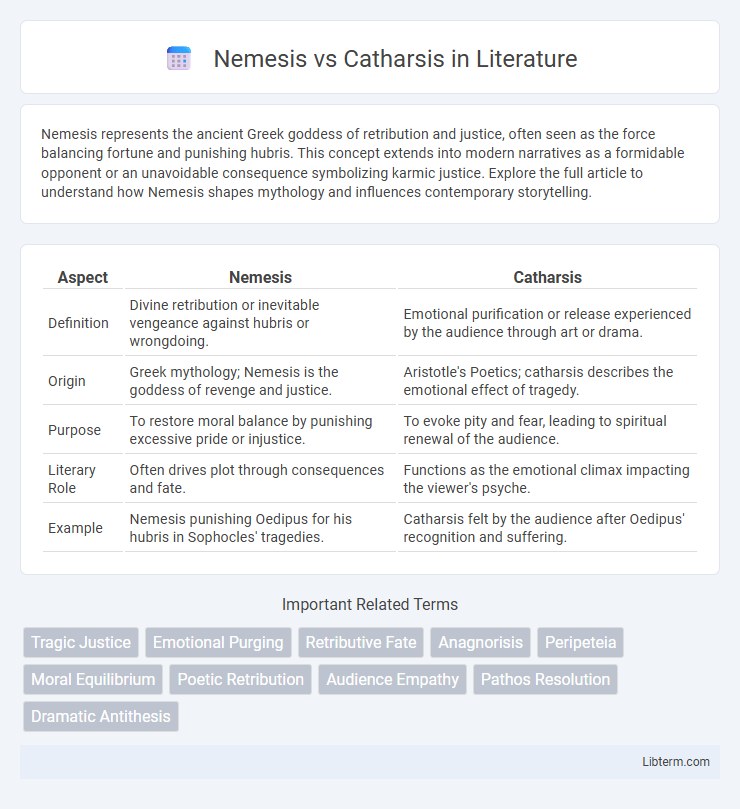Nemesis represents the ancient Greek goddess of retribution and justice, often seen as the force balancing fortune and punishing hubris. This concept extends into modern narratives as a formidable opponent or an unavoidable consequence symbolizing karmic justice. Explore the full article to understand how Nemesis shapes mythology and influences contemporary storytelling.
Table of Comparison
| Aspect | Nemesis | Catharsis |
|---|---|---|
| Definition | Divine retribution or inevitable vengeance against hubris or wrongdoing. | Emotional purification or release experienced by the audience through art or drama. |
| Origin | Greek mythology; Nemesis is the goddess of revenge and justice. | Aristotle's Poetics; catharsis describes the emotional effect of tragedy. |
| Purpose | To restore moral balance by punishing excessive pride or injustice. | To evoke pity and fear, leading to spiritual renewal of the audience. |
| Literary Role | Often drives plot through consequences and fate. | Functions as the emotional climax impacting the viewer's psyche. |
| Example | Nemesis punishing Oedipus for his hubris in Sophocles' tragedies. | Catharsis felt by the audience after Oedipus' recognition and suffering. |
Understanding Nemesis: Definition and Origins
Nemesis, rooted in Greek mythology, represents divine retribution against hubris and moral transgression, serving as a personification of balanced justice. Originating from the Greek goddess Nemesis, she embodies the inevitable punishment that restores equilibrium when individuals overstep ethical boundaries. Understanding Nemesis involves recognizing its role in ancient narratives as a mechanism enforcing moral order and deterring excessive pride.
Exploring Catharsis: Meaning and Historical Context
Catharsis, originating from Aristotle's Poetics, refers to the emotional release experienced by an audience through art, particularly tragedy, where feelings of pity and fear are purified. Historically, catharsis served as a crucial concept in classical Greek drama, emphasizing the psychological and moral cleansing that leads to emotional renewal. This process contrasts with Nemesis, which embodies retributive justice, highlighting catharsis as a transformative emotional experience rather than punishment.
Key Differences Between Nemesis and Catharsis
Nemesis represents divine retribution or inevitable punishment for hubris and wrongdoing, while catharsis refers to the emotional purification and release experienced by the audience through art or drama. Nemesis enforces justice and balance by delivering consequences to characters, whereas catharsis facilitates psychological relief and renewed emotional clarity. The key difference lies in nemesis as an external force of moral reckoning, contrasted with catharsis as an internal emotional transformation within individuals.
Nemesis in Literature and Mythology
Nemesis in literature and mythology embodies retributive justice, serving as the inescapable force that punishes hubris and moral transgressions. Rooted in Greek mythology, Nemesis acts as the divine agent ensuring balance by avenging arrogance and excessive pride, often leading characters to face inevitable downfall. This concept underscores themes of fate, justice, and moral consequence, distinguishing Nemesis as a critical symbol of cosmic justice in classical narratives.
Catharsis as a Psychological Concept
Catharsis refers to the psychological process of releasing and thereby providing relief from strong or repressed emotions, often achieved through art, therapy, or emotional expression. This concept plays a crucial role in emotional regulation, allowing individuals to process trauma or stress and achieve mental clarity and healing. Unlike Nemesis, which embodies retributive justice or vengeance, Catharsis emphasizes emotional purification and psychological renewal.
The Role of Nemesis in Storytelling
Nemesis serves as the indispensable force of justice in storytelling, embodying retribution against hubris and moral transgressions. This antagonist or fate-driven element intensifies narrative tension by challenging protagonists, compelling growth or downfall through inevitable consequences. Its role often symbolizes the balance of cosmic order, reinforcing themes of accountability and ethical equilibrium in literary works.
How Catharsis Shapes Reader’s Emotions
Catharsis shapes readers' emotions by providing a powerful emotional release through the resolution of conflict, allowing them to experience relief and purification. In literature, this emotional cleansing fosters empathy and deeper understanding of characters' struggles, intensifying the impact of the narrative. By evoking pity and fear, catharsis connects readers to the story on a psychological level, making the experience profoundly transformative.
Nemesis and Catharsis: Interplay in Tragedy
Nemesis and catharsis represent crucial elements in classical tragedy, where Nemesis embodies retributive justice punishing hubris, and catharsis serves as the emotional purging of pity and fear in the audience. The interplay between Nemesis and catharsis drives the tragic narrative by ensuring that the protagonist's excessive pride leads to inevitable downfall, evoking a powerful emotional release. This dynamic reinforces moral order while providing psychological relief, making the tragedy a profound exploration of human flaws and cosmic justice.
Modern Interpretations of Nemesis and Catharsis
Modern interpretations of Nemesis emphasize the concept of cosmic justice and inevitable retribution, often explored in literature and psychology as a mechanism for balancing hubris and moral failures. Catharsis is reinterpreted in contemporary drama and therapy as a powerful emotional release, enabling individuals to process trauma and achieve psychological healing. Together, Nemesis and Catharsis illustrate the dynamic interplay between justice and emotional transformation in human experience.
The Impact of Nemesis and Catharsis on Audience Experience
Nemesis and catharsis play crucial roles in shaping the audience's emotional journey, where nemesis delivers a sense of just retribution that satisfies the desire for moral balance. Catharsis facilitates emotional release, allowing viewers to experience relief and renewal through the protagonist's trials and resolution. Together, these elements deepen engagement by evoking empathy and providing psychological closure, enhancing the overall impact of storytelling in drama and literature.
Nemesis Infographic

 libterm.com
libterm.com